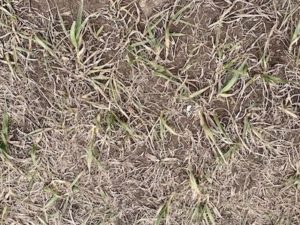
Water Rights Are a Reality
For those in the eastern part of the United States, experiencing floods and routine rainfalls, the stark reality of droughts is less dire. Irrigation for crops is typically available and limited water for household access occurs only when lawn irrigation is restricted in the driest of times. However, having access to or limitations on water usage in the western United States is a different reality for agriculture production, especially where drought conditions are deemed the “worst in a century.”1
Over the past several summers during my Colorado reprieve from the Kentucky humidity, I’ve had the opportunity to understand what water rights really mean for agriculture production. For example, the Colorado River is the water source for seven states within the United States and two states in northern Mexico. Nearly 40 million Americans rely on the Colorado River system for their drinking water and their livelihoods, which range from farming to recreation.2
Recognizing the importance of water distribution and use, Colorado was the first state to pass legislation back in 1879 that still provides the foundation for the distribution system today. Due to the foresight of previous generations, Palisade, Colorado, (along the I-70 corridor near Grand Junction) is known for its orchards and vegetables, as water canals were constructed along the Colorado River providing irrigation for agricultural production. However, the availability of water is not taken lightly by the orchard growers, nor do they have free rein of use. Timing and quantity of water use is often coordinated by neighboring producers and is routinely monitored by the local regulatory body.

The Agricultural Dependency
Food production is vital to our existence … and so is water. When we look at the use of water for agricultural production, often the discussion (and sometimes, legal action) erupts on who has the right to water. According to the USDA Economic Research Service, “agriculture is a major user of ground and surface water in the United States, accounting for approximately 80 percent of the Nation’s consumptive water use and over 90 percent in many Western States.”3 It will be important for the initiation of efficient irrigation systems and water management practices to help maintain farm profitability in an era of increasingly limited and more costly water supplies. Approximately 75% of all irrigated farm land is in the 17 most western states, but overall, irrigated agricultural areas provide approximately half of the country’s crop sales. Vegetables and orchards account for 16% of irrigated land use while soybean and corn production account for 14 and 25%, respectively.

Whose Right is It?
As neighborhoods develop on arid land, the competition for water use will continue. Drinking water for all is essential but so is food. As a whole, we are fortunate to have access to fresh water in this country. More than one billion people still do not have that luxury.5 Water conservation like food waste is everyone’s responsibility. Consider our personal lifestyle habits:
- Do we keep irrigation systems on lawns and golf courses even when the ground is saturated?
- Do we ignore dripping faucets or water lines?
- Do we run the dishwasher or clothes washer with less than full loads?
- Do we keep the water running when brushing our teeth?
Often times, agriculture production restrictions are pitted against our own desire for unrestricted use. Do we desire to have manicured lawns and golf courses or access to fresh fruits or vegetables? Regardless of our location and occupation, we must recognize water is not to be taken for granted. Water is the core of our own existence. It is up to us to determine our future.
References
1. “EXTREME WEATHER: Drought Spreads to 93% of West. That’s Never Happened,” ClimateWire, July 7, 2021.
2. Colorado River Basin Water Supply and Demand Study, U.S. Department of the Interior Bureau of Reclamation, December 2012.
3. Irrigation & Water Use, U.S. Department of Agriculture Economic Research Service.
4. “Historic drought in the West is forcing ranchers to take painful measures,” Sarah Gibbens, National Geographic, June 29, 2021.
5. United Nations Sustainable Development Goals, Goal 12: Ensure Sustainable Consumption And Production Patterns.
